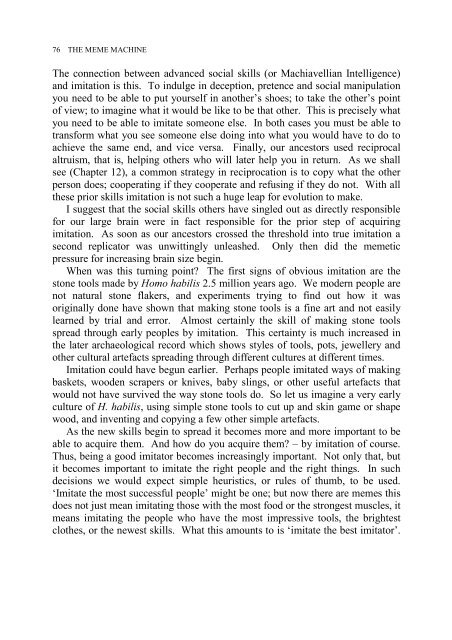The Meme Machine
TheMemeMachine1999
TheMemeMachine1999
- No tags were found...
You also want an ePaper? Increase the reach of your titles
YUMPU automatically turns print PDFs into web optimized ePapers that Google loves.
76 THE MEME MACHINE<br />
<strong>The</strong> connection between advanced social skills (or Machiavellian Intelligence)<br />
and imitation is this. To indulge in deception, pretence and social manipulation<br />
you need to be able to put yourself in another’s shoes; to take the other’s point<br />
of view; to imagine what it would be like to be that other. This is precisely what<br />
you need to be able to imitate someone else. In both cases you must be able to<br />
transform what you see someone else doing into what you would have to do to<br />
achieve the same end, and vice versa. Finally, our ancestors used reciprocal<br />
altruism, that is, helping others who will later help you in return. As we shall<br />
see (Chapter 12), a common strategy in reciprocation is to copy what the other<br />
person does; cooperating if they cooperate and refusing if they do not. With all<br />
these prior skills imitation is not such a huge leap for evolution to make.<br />
I suggest that the social skills others have singled out as directly responsible<br />
for our large brain were in fact responsible for the prior step of acquiring<br />
imitation. As soon as our ancestors crossed the threshold into true imitation a<br />
second replicator was unwittingly unleashed. Only then did the memetic<br />
pressure for increasing brain size begin.<br />
When was this turning point? <strong>The</strong> first signs of obvious imitation are the<br />
stone tools made by Homo habilis 2.5 million years ago. We modern people are<br />
not natural stone flakers, and experiments trying to find out how it was<br />
originally done have shown that making stone tools is a fine art and not easily<br />
learned by trial and error. Almost certainly the skill of making stone tools<br />
spread through early peoples by imitation. This certainty is much increased in<br />
the later archaeological record which shows styles of tools, pots, jewellery and<br />
other cultural artefacts spreading through different cultures at different times.<br />
Imitation could have begun earlier. Perhaps people imitated ways of making<br />
baskets, wooden scrapers or knives, baby slings, or other useful artefacts that<br />
would not have survived the way stone tools do. So let us imagine a very early<br />
culture of H. habilis, using simple stone tools to cut up and skin game or shape<br />
wood, and inventing and copying a few other simple artefacts.<br />
As the new skills begin to spread it becomes more and more important to be<br />
able to acquire them. And how do you acquire them? – by imitation of course.<br />
Thus, being a good imitator becomes increasingly important. Not only that, but<br />
it becomes important to imitate the right people and the right things. In such<br />
decisions we would expect simple heuristics, or rules of thumb, to be used.<br />
‘Imitate the most successful people’ might be one; but now there are memes this<br />
does not just mean imitating those with the most food or the strongest muscles, it<br />
means imitating the people who have the most impressive tools, the brightest<br />
clothes, or the newest skills. What this amounts to is ‘imitate the best imitator’.



